This post was printed in the September 2011 issue of Doors & Hardware
Stairwell doors are often locked on the stair side to prevent unauthorized entry into tenant spaces. The term “stairwell reentry” refers to the code requirements which allow a building occupant to leave a stairwell during a fire emergency, and find another exit. If stairwell doors do not allow for reentry and a stairwell becomes impassible, it can jeopardize the lives of those using the stairwell as a means of egress. There are quite a few myths surrounding this requirement, which I will address below.
Myth: Only high-rise buildings are required to comply with stairwell reentry requirements.
Fact: There have been many changes to this section of the code in the last ten years, which is why there is so much confusion surrounding it. The 2000 edition of the International Building Code (IBC) and the model building codes that existed prior contained reentry requirements for high-rise buildings, but required passage sets for stair doors that were not in high-rise buildings. The fail safe locks or fail safe exit device trim required for reentry were sometimes allowed in buildings that were not high-rise buildings, but there was no option in the IBC or the model codes for mechanical locks on stair doors, except the stair discharge.
The 2003 edition of the IBC added an exception which allowed mechanical locks on stair doors if the stair was serving 4 stories or less, but the change was short-lived. In the 2006 edition of the IBC, that exception was changed to require remote unlocking from the fire command center or a location inside the building’s main entrance, effectively removing the exception for mechanical locks. This language remained unchanged in the 2009 edition of the IBC, and the 2012 edition is basically the same with the addition of language pertaining to certain occupancies with a single exit stair.
Although NFPA 101 – The Life Safety Code, and NFPA 5000 – The Building Construction and Safety Code DO allow mechanical locks on stair doors serving 4 stories or less, this only applies to buildings where one of these codes is being enforced. The IBC is currently the predominant building code for most jurisdictions, and the majority of buildings must be built in accordance with the IBC.
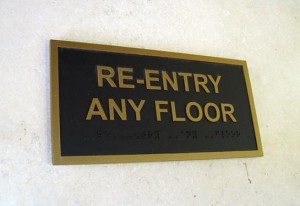 Myth: The door to every fifth floor must be unlocked, but the doors to the rest of the floors can be locked.
Myth: The door to every fifth floor must be unlocked, but the doors to the rest of the floors can be locked.
Fact: The requirement for every fifth floor to be unlocked is part of the “selected reentry” conditions in NFPA 101 – The Life Safety Code and NFPA 5000 – The Building Construction and Safety Code. This section requires at least 2 doors in a stair to be unlocked, no more than 4 locked floors between unlocked floors, either the top or next to top level must be unlocked and must allow access to another exit, the doors allowing reentry must be marked as such, and doors not allowing reentry must have signage which indicates the closest unlocked door in each direction. Again, this only applies to buildings where one of these codes is being enforced – the IBC does not include the selected reentry option. I have only seen selected reentry used on one project that I have specified, and in my opinion the codes were being creatively applied in that case.
Myth: A fail safe electric strike can be used on a stair door to provide reentry.
Fact: Stair doors providing reentry typically have a fail safe lock or fail safe exit device trim, which unlocks the lever handle upon fire alarm / power failure, but does not unlatch the door. A fail safe electric strike will not maintain the positive latching required for fire rated doors, and the pressure from a fire could push the door open, allowing smoke and flames to enter the stairwell. The IBC specifically states that stair doors must unlock “without unlatching.” There is another type of electrified hardware that is occasionally used for stairwell reentry – sometimes called a “Hitower Lock” (a brand name). This is a frame-mounted device that controls the locking/unlocking via a lock modification. It’s not an electric strike, but it mounts in the same location so it could be confused with one.
Myth: The stairwell reentry requirements state that stair doors must unlock automatically upon fire alarm.
Fact: There is a slight distinction between codes, but the IBC states that the stair doors must be “capable of being unlocked simultaneously without unlatching upon a signal from the fire command center, if present, or a signal by emergency personnel from a single location inside the main entrance to the building,” while NFPA 101 states that “an automatic release that is actuated with the initiation of the building fire alarm system shall be provided to unlock all stair enclosure doors to allow re-entry.” The same type of hardware – fail safe locks or fail safe exit device trim – is used in either case, but the fire alarm interface will be different. Please note that there are additional requirements for two-way communication in the stairwell when stair doors do not allow free access at all times.
Myth: Both sides of a stair door can be locked as long as the door unlocks upon fire alarm.
Fact: I can’t count the number of times an architect or end user has asked me to specify hardware for a door that is locked all the time except during a fire alarm. If a door is a required egress door, there are VERY limited applications that would allow the door to be locked in the direction of egress – NFPA 101 lists exceptions for certain existing occupancies, buildings permitted to have a single exit, and certain health care and detention/correctional occupancies. Most stair doors must allow free egress from the non-stair side at all times, and if there is a need to limit egress the two options would be delayed egress hardware which delays egress for 15 seconds, or an alarm to discourage use of the door. Note that delayed egress locks are not allowed in every occupancy type, and there are additional code requirements for doors equipped with delayed egress locks.
Myth: Stair discharge doors opening to the exterior must unlock automatically upon fire alarm to allow firefighter access to the stair.
Fact: The IBC specifically states that “stairway discharge doors shall be openable from the egress side and shall only be locked from the opposite side.” There is no requirement in the IBC or NFPA 101/5000 for the exterior doors to automatically unlock and provide firefighter access, although it may be required by some local jurisdictions. Unlocking these doors automatically upon fire alarm would impact the building’s security, and there are other ways for firefighters to gain access. If remote release of the stair discharge doors is required by a local jurisdiction, I would highly recommend that these doors be controlled by a switch at the fire command center, rather than unlocked automatically upon fire alarm.
Stairwell reentry is an important feature of life safety, and the requirements are often misunderstood or stair doors modified after the building is completed. With proper attention and education, tragedies like the death of 6 people in the stairwell of Chicago’s Cook County Administration Building (2003) may be averted.
This post was originally created on August 28, 2011, and was printed in the September 2011 issue of Doors & Hardware magazine. It was updated on March 31, 2012, and will be printed in Locksmith Ledger’s June 2013 issue.
You need to login or register to bookmark/favorite this content.

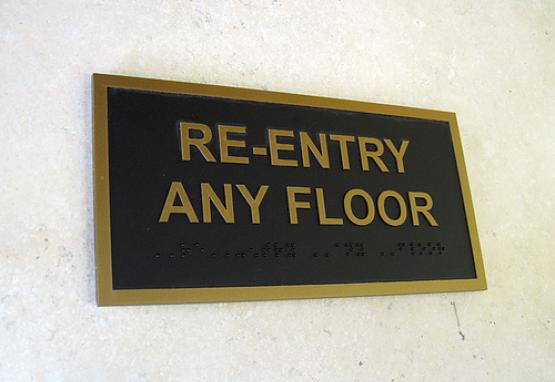

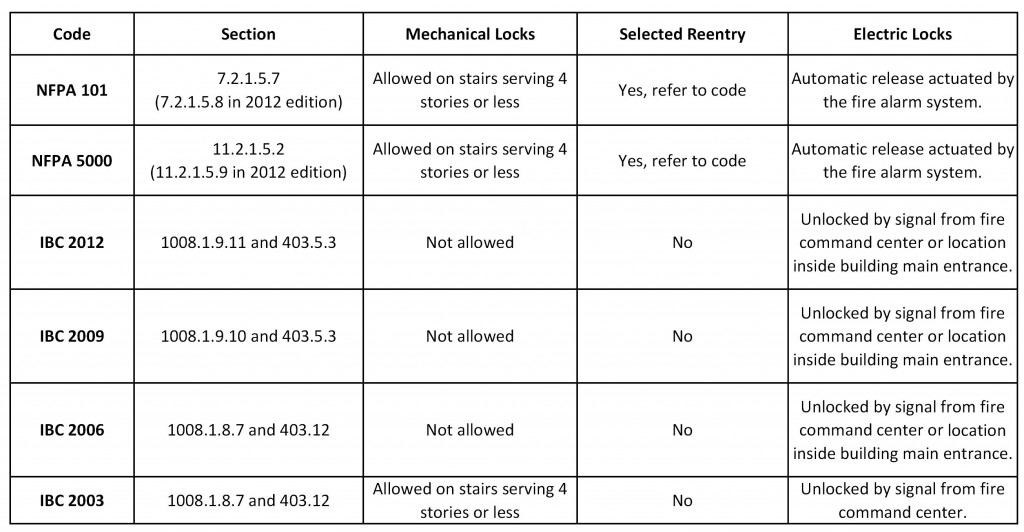


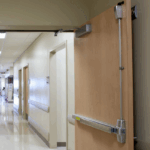
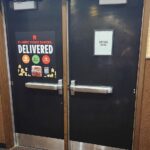
Great article Lori! I thought I understood it exactly the way you just explained it all, but it’s good to have clarification and confirmation!
Would love an artile on how to handle DE doors in healthcare facilities, where security & life safety both need to be considered. ASHE has put out a comparison of 2000, 2003, 2006, and 2009 versions of the Life Safety Code – and recommendations on how a facility can apply to comply with an advance version of the code. The 2009 version has some added language (and omitted language) that seems to lend itself a bit more to the physical security requirements of healthcare facilities. But the age old question of safety vs security remains a complex topic.
Not sure if I am following the second fact, but from the IBC and IFC:
1008.1.8.7 Stairway doors. Interior stairway means of egress doors shall be openable from both sides without
the use of a key or special knowledge or effort.
Exceptions:
1. Stairway discharge doors shall be openable from the egress side and shall only be locked from the opposite side.
2. This section shall not apply to doors arranged in accordance with Section 403.12 of the International
Building Code.
3. In stairways serving not more than four stories, doors are permitted to be locked from the side opposite the egress side, provided they are openable from the egress side.
403.12 Stair way door operation. Stairway doors other than the exit discharge doors shall be permitted to be locked from stairway side. Stair way doors that are locked from the stairway side shall be capable of being unlocked simultaneously with out unlatching upon a signal from the fire command center.
Hi Charles –
The 2003 editions of the IBC and IFC allowed mechanical locking on stairs serving 4 stories or less, but the editions before and after require fail safe electrified locks for remote unlocking.
Hi Lori:
I look forward to your column every issue of DH Magazine
Your fans and followers might also find this article of interest:
The Chicago Stairwell Fire: A case study in codes, emergency response & life safety – Tim O’Leary, Mar., p. 14
So I am on a project now and I am being asked if 403.12.1 applies and we have to have a phone in the stairwell.
I have read just about everything I can seem to find and I don’t know how we would not need one. The building is over 70′ the distributor is providing L9080EL-RX lock but we were not putting a phone system in the stairwell which it now seems we need to.
Your thoughts?
Yes, I believe you would need a phone at least every 5th floor in the stairway if you are locking the stair doors.
This is the section from the 2009 IBC:
403.5.3 Stairway door operation. Stairway doors other than the exit discharge doors shall be permitted to be locked from the stairway side. Stairway doors that are locked from the stairway side shall be capable of being unlocked simultaneously without unlatching upon a signal from the fire command center.
403.5.3.1 Stairway communication system. A telephone or other two-way communications system connected to an approved constantly attended station shall be provided at not less than every fifth floor in each stairway where the doors to the stairway are locked.
Lori, do you like to combine visit work and pleasure, please visit me at the Aquarium and review some of critical spots for employee and visitors evacuation.
Thanks,
Jurek
I’ve heard that the Monterey Bay Aquarium is very proactive with regard to fire and egress doors, but if I’m going to be in the neighborhood, I’ll let you know! 🙂
By fire code can you lock the bottom stairwell door to prevent entry into the building so long as it will unlock to get out of the building?
I have a highrise office building that does not meet IBC 2003 codes.The stairwell doors are mechanically locked and can`t unlock doors for reentry to floor. Owners are telling me that they are using NFPA 101 code. My thinking is 101 requires stairwell to be unlocked on alarm. Can I get codes allowing these doors to not unlock for re-entry. If codes exist I would like to know where to find them in 101.
Thank you.
Hi Butch –
NFPA 101 does allow some doors to be mechanically locked – if the stair is serving 4 stories or less, or if the “selected reentry” requirements of NFPA 101 are used (the IBC does not include selected reentry). Selected reentry allows some doors to be mechanically locked, with other doors allowing reentry. There are also some exceptions in 101 for certain types of buildings.
I found this in the chapter that covers existing business occupancies:
39.2.2.2.4 The re-entry provisions of 7.2.1.5.8 shall not apply to any of the following:
(1) Existing business occupancies that are not high-rise buildings
(2) Existing high-rise business occupancy buildings that are protected throughout by an approved automatic sprinkler system in accordance with 9.7.1.1(1)
(3) Existing high-rise business occupancy buildings havingapproved existing means for providing stair re-entry
– Lori
I am working on an Area of Refuge design for a 23 story building. I am trying to decide if I will need AOR stations in the stairwells as in IBC 403.5.3.1. In this application stair 01, floors 01-08, serve a public parking garage and will be unlocked. There will be a gate installed in stair 01 between the 8th and 9th floors with access control to restrict access to the upper floors. Stair 01, floors 09-19, will provide access to apartments and will also be unlocked. Stair 01, floors 20-23, shall have access control installed restricting reentry. Stair 02, floors 03-08, will have access control installed restricting reentry. There will be another gate installed in stair 02 between floors 08 & 09 with access control to restrict access to the upper floors. Stair 02, floors 09-19 will provide access to apartments and will be unlocked. Stair 02, floors 20-23, shall have access control installed restricting reentry. The majority of stairwell 01 shall be unlocked (except floors 20-23) so I do not think I would need any AOR stations. Stairwell 02 will be locked on floors 03-08 and 20-23. Would I need to install an AOR device on the 7th floor of stair 02?
Hi Mike –
I can’t answer that one…maybe your local AHJ would be willing to help?
– Lori
I have read just about everything I can seem to find and I don’t know how we would not need one. The building is over 70′ the distributor is providing L9080EL-RX lock but we were not putting a phone system in the stairwell which it now seems we need to.
If the building is a high-rise and the stair doors will be lockable on the stair side, the IBC requires a 2-way communication system in the stairwell – at every 5th floor. Here’s where it says so:
403.5.3 Stairway door operation. Stairway doors other than the exit discharge doors shall be permitted to be locked from the stairway side. Stairway doors that are locked from the stairway side shall be capable of being unlocked simultaneously without unlatching upon a signal
from the fire command center.
403.5.3.1 Stairway communication system. A telephone or other two-way communications system connected to an approved constantly attended station shall be provided at not less than every fifth floor in each stairway where the doors to the stairway are locked.
– Lori